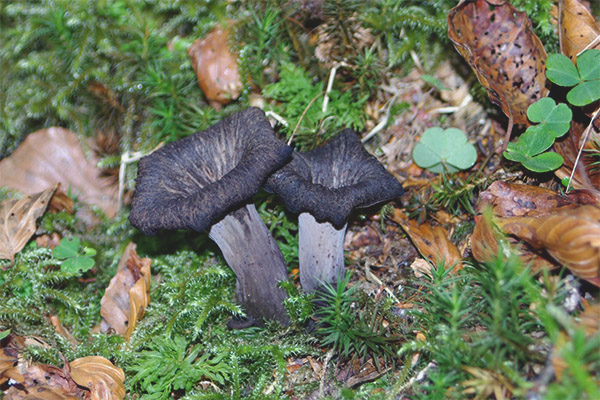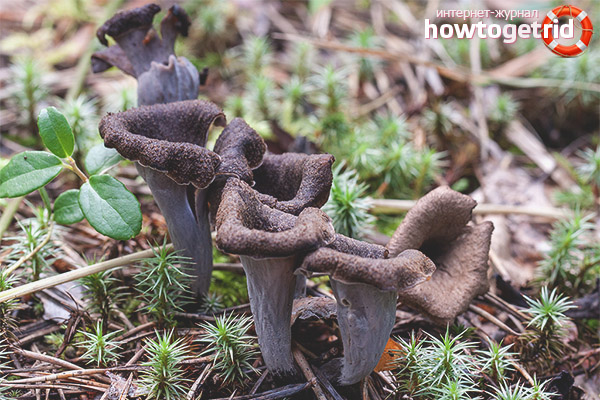The content of the article
The fungus is a funnel horn-shaped, belonging to the fox family. The fungus also has other names, for example, funnel gray. Sometimes it is called the corneal trucosa. In the people, sometimes you can hear the name Gray Fox, which is erroneous.
Since the shape of this mushroom is unusual, many names are associated precisely with its appearance. For example, in Finland it is called the black horn. The British call this species a cornucopia, the French - the pipe of death. And if you translate the name from German, it will mean "pipe of the dead."
Description
The fruit body of representatives of this species has the form of a tube or bowl, which becomes closer to the base. The height of the mushrooms ranges from 5 to 12 cm. Inside they are hollow. The cap has a recess that smoothly passes into the cavity of the leg of the fungus.
The cap of the funnel has a funnel shape. Its diameter is small, on average 4-8 cm., The edge of the cap is wavy, it is somewhat turned outward. In an adult fungus, it is torn or has blades.The inner surface has a fibrous structure, covered with small scales. In young specimens, it has a dark brown color, and in adult mushrooms it becomes gray or even almost black.
Representatives of this species do not have pseudoplates, which are a characteristic feature of chanterelles. The color of the spore powder is white or slightly yellow. The stem of these mushrooms is short, its thickness is slightly less than 1 cm. At the base it is narrowed, tough to the touch. The hat and leg have the same shade.
Have a fragile flesh. At first, the mushrooms are characterized by dark gray flesh, and adult specimens are almost black. It is noteworthy that raw mushrooms have almost no smell and taste.They become more pronounced after drying or cooking.
Where grows
As a rule, it is indicated as a mycorrhiza fungus, but some sources state that these are saprophytes.
Representatives of this species grow on the soil. They can be seen in any forest, except conifers, prefer high humidity. Can grow on calcareous, as well as clay soil. Sometimes it grows on fallen leaves. Favorite places of growth are light open areas, roadsides and edges of ditches. You can often meet in the mountains. As a rule, these mushrooms grow in groups or colonies. But to see them against the background of fallen leaves is not easy, as they blend into this background in color.
In the Northern Hemisphere, this species is quite common. Most of them grow in temperate climates, are found up to the tropics. There are they in the territory of Eurasia, North America. In Russia, these mushrooms can be seen almost throughout the European part of the country, in the Far East. There are them in Siberia, as well as in the Altai Territory.
The period of fruiting lasts from July to October.In regions with a warm climate, where snow does not fall in winter, they can be collected even in November.
Similar species
It is easy to distinguish mushrooms of this species. They have a characteristic cupped shape, dark color, grow in groups.
One of the similar species is the sinuous funnel. Distinctive features of this species are the lighter coloring of the fungus. They are yellowish, their cap is more dissected.
These mushrooms are also a bit like a goblet urn. These are dense, glass-shaped mushrooms. Painted in almost black. And the funnel differs from them in that its flesh is more fragile. The mushroom has the shape of a bowl, and their edge is somewhat turned away.
Edibility
Voronochny horn-shaped can be eaten. In Western Europe, it is a delicacy. Pre-treatment of these mushrooms is not required. The leg of the fungus is not eaten. When cooking, use only their tubular funnel. They are added to various fried dishes, stewed.They perfectly complement the taste of soup, sauces, and various seasonings.
During cooking, they become black. They can be dried, but after that the flesh becomes brittle, and begins to crumble. But the taste is somewhat improved. Usually in this form the funnel is added when cooking sauces.












To send